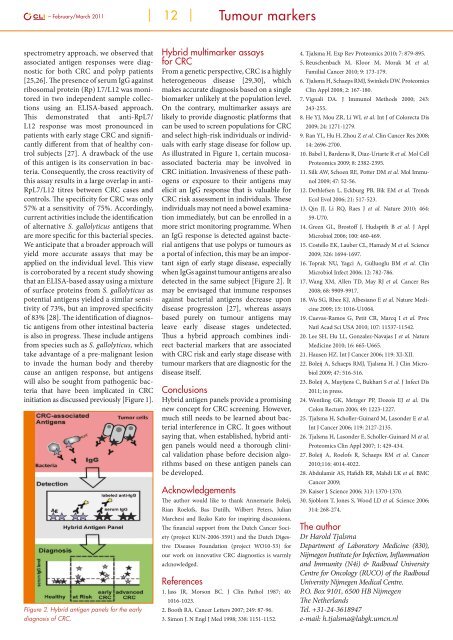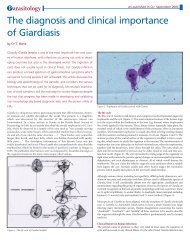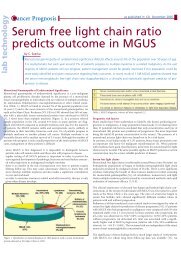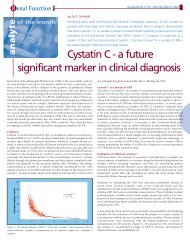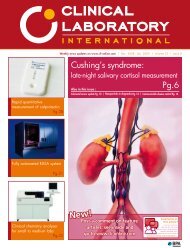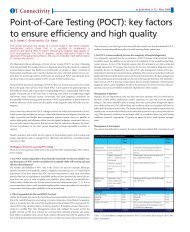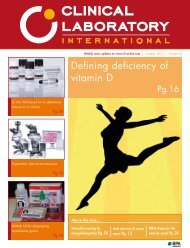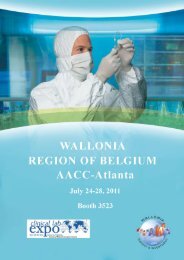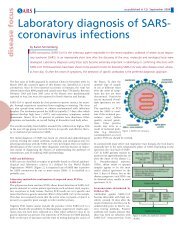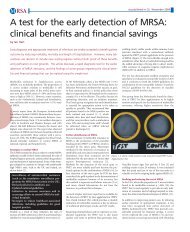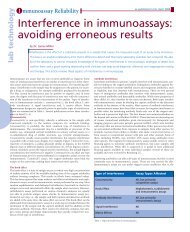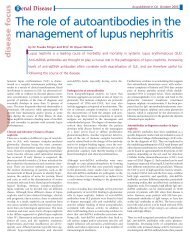Screening for cancer: are biomarkers of value?
Screening for cancer: are biomarkers of value?
Screening for cancer: are biomarkers of value?
You also want an ePaper? Increase the reach of your titles
YUMPU automatically turns print PDFs into web optimized ePapers that Google loves.
– February/March 2011 12 Tumour markers<br />
spectrometry approach, we observed that<br />
associated antigen responses were diagnostic<br />
<strong>for</strong> both CRC and polyp patients<br />
[25,26]. The presence <strong>of</strong> serum IgG against<br />
ribosomal protein (Rp) L7/L12 was monitored<br />
in two independent sample collections<br />
using an ELISA-based approach.<br />
This demonstrated that anti-RpL7/<br />
L12 response was most pronounced in<br />
patients with early stage CRC and significantly<br />
different from that <strong>of</strong> healthy control<br />
subjects [27]. A drawback <strong>of</strong> the use<br />
<strong>of</strong> this antigen is its conservation in bacteria.<br />
Consequently, the cross reactivity <strong>of</strong><br />
this assay results in a large overlap in anti-<br />
RpL7/L12 titres between CRC cases and<br />
controls. The specificity <strong>for</strong> CRC was only<br />
57% at a sensitivity <strong>of</strong> 75%. Accordingly,<br />
current activities include the identification<br />
<strong>of</strong> alternative S. gallolyticus antigens that<br />
<strong>are</strong> more specific <strong>for</strong> this bacterial species.<br />
We anticipate that a broader approach will<br />
yield more accurate assays that may be<br />
applied on the individual level. This view<br />
is corroborated by a recent study showing<br />
that an ELISA-based assay using a mixture<br />
<strong>of</strong> surface proteins from S. gallolyticus as<br />
potential antigens yielded a similar sensitivity<br />
<strong>of</strong> 73%, but an improved specificity<br />
<strong>of</strong> 83% [28]. The identification <strong>of</strong> diagnostic<br />
antigens from other intestinal bacteria<br />
is also in progress. These include antigens<br />
from species such as S. gallolyticus, which<br />
take advantage <strong>of</strong> a pre-malignant lesion<br />
to invade the human body and thereby<br />
cause an antigen response, but antigens<br />
will also be sought from pathogenic bacteria<br />
that have been implicated in CRC<br />
initiation as discussed previously [Figure 1].<br />
FIigure 2. Hybrid antigen panels <strong>for</strong> the early<br />
diagnosis <strong>of</strong> CRC.<br />
Hybrid multimarker assays<br />
<strong>for</strong> CRC<br />
From a genetic perspective, CRC is a highly<br />
heterogeneous disease [29,30], which<br />
makes accurate diagnosis based on a single<br />
biomarker unlikely at the population level.<br />
On the contrary, multimarker assays <strong>are</strong><br />
likely to provide diagnostic plat<strong>for</strong>ms that<br />
can be used to screen populations <strong>for</strong> CRC<br />
and select high-risk individuals or individuals<br />
with early stage disease <strong>for</strong> follow up.<br />
As illustrated in Figure 1, certain mucosaassociated<br />
bacteria may be involved in<br />
CRC initiation. Invasiveness <strong>of</strong> these pathogens<br />
or exposure to their antigens may<br />
elicit an IgG response that is valuable <strong>for</strong><br />
CRC risk assessment in individuals. These<br />
individuals may not need a bowel examination<br />
immediately, but can be enrolled in a<br />
more strict monitoring programme. When<br />
an IgG response is detected against bacterial<br />
antigens that use polyps or tumours as<br />
a portal <strong>of</strong> infection, this may be an important<br />
sign <strong>of</strong> early stage disease, especially<br />
when IgGs against tumour antigens <strong>are</strong> also<br />
detected in the same subject [Figure 2]. It<br />
may be envisaged that immune responses<br />
against bacterial antigens decrease upon<br />
disease progression [27], whereas assays<br />
based purely on tumour antigens may<br />
leave early disease stages undetected.<br />
Thus a hybrid approach combines indirect<br />
bacterial markers that <strong>are</strong> associated<br />
with CRC risk and early stage disease with<br />
tumour markers that <strong>are</strong> diagnostic <strong>for</strong> the<br />
disease itself.<br />
Conclusions<br />
Hybrid antigen panels provide a promising<br />
new concept <strong>for</strong> CRC screening. However,<br />
much still needs to be learned about bacterial<br />
interference in CRC. It goes without<br />
saying that, when established, hybrid antigen<br />
panels would need a thorough clinical<br />
validation phase be<strong>for</strong>e decision algorithms<br />
based on these antigen panels can<br />
be developed.<br />
Acknowledgements<br />
The author would like to thank Annemarie Boleij,<br />
Rian Roel<strong>of</strong>s, Bas Dutilh, Wilbert Peters, Julian<br />
Marchesi and Ikuko Kato <strong>for</strong> inspiring discussions.<br />
The financial support from the Dutch Cancer Society<br />
(project KUN-2006-3591) and the Dutch Digestive<br />
Diseases Foundation (project WO10-53) <strong>for</strong><br />
our work on innovative CRC diagnostics is warmly<br />
acknowledged.<br />
References<br />
1. Jass JR, Morson BC. J Clin Pathol 1987; 40:<br />
1016-1023.<br />
2. Booth RA. Cancer Letters 2007; 249: 87-96.<br />
3. Simon J. N Engl J Med 1998; 338: 1151-1152.<br />
4. Tjalsma H. Exp Rev Proteomics 2010; 7: 879-895.<br />
5. Reuschenbach M, Kloor M, Morak M et al.<br />
Familial Cancer 2010; 9: 173-179.<br />
6. Tjalsma H, Schaeps RMJ, Swinkels DW. Proteomics<br />
Clin Appl 2008; 2: 167-180.<br />
7. Vignali DA. J Immunol Methods 2000; 243:<br />
243-255.<br />
8. He YJ, Mou ZR, Li WL et al. Int J <strong>of</strong> Colorecta Dis<br />
2009; 24: 1271-1279.<br />
9. Ran YL, Hu H, Zhou Z et al. Clin Cancer Res 2008;<br />
14: 2696-2700.<br />
10. Babel I, Barderas R, Diaz-Uriarte R et al. Mol Cell<br />
Proteomics 2009; 8: 2382-2395.<br />
11. Silk AW, Schoen RE, Potter DM et al. Mol Immunol<br />
2009; 47: 52-56.<br />
12. Dethlefsen L, Eckburg PB, Bik EM et al. Trends<br />
Ecol Evol 2006; 21: 517-523.<br />
13. Qin JJ, Li RQ, Raes J et al. Nature 2010; 464:<br />
59-U70.<br />
14. Green GL, Brost<strong>of</strong>f J, Hudspith B et al. J Appl<br />
Microbiol 2006; 100: 460-469.<br />
15. Costello EK, Lauber CL, Hamady M et al. Science<br />
2009; 326: 1694-1697.<br />
16. Toprak NU, Yagci A, Gulluoglu BM et al. Clin<br />
Microbiol Infect 2006; 12: 782-786.<br />
17. Wang XM, Allen TD, May RJ et al. Cancer Res<br />
2008; 68: 9909-9917.<br />
18. Wu SG, Rhee KJ, Albesiano E et al. Nature Medicine<br />
2009; 15: 1016-U1064.<br />
19. Cuevas-Ramos G, Petit CR, Marcq I et al. Proc<br />
Natl Acad Sci USA 2010; 107: 11537-11542.<br />
20. Lee SH, Hu LL, Gonzalez-Navajas J et al. Nature<br />
Medicine 2010; 16: 665-U665.<br />
21. Hausen HZ. Int J Cancer 2006; 119: XI-XII.<br />
22. Boleij A, Schaeps RMJ, Tjalsma H. J Clin Microbiol<br />
2009; 47: 516-516.<br />
23. Boleij A, Muytjens C, Bukhari S et al. J Infect Dis<br />
2011; in press.<br />
24. Wentling GK, Metzger PP, Dozois EJ et al. Dis<br />
Colon Rectum 2006; 49: 1223-1227.<br />
25. Tjalsma H, Scholler-Guinard M, Lasonder E et al.<br />
Int J Cancer 2006; 119: 2127-2135.<br />
26. Tjalsma H, Lasonder E, Scholler-Guinard M et al.<br />
Proteomics Clin Appl 2007; 1: 429-434.<br />
27. Boleij A, Roel<strong>of</strong>s R, Schaeps RM et al. Cancer<br />
2010;116: 4014-4022.<br />
28. Abdulamir AS, Hafidh RR, Mahdi LK et al. BMC<br />
Cancer 2009;<br />
29. Kaiser J. Science 2006; 313: 1370-1370.<br />
30. Sjoblom T, Jones S, Wood LD et al. Science 2006;<br />
314: 268-274.<br />
The author<br />
Dr Harold Tjalsma<br />
Department <strong>of</strong> Laboratory Medicine (830),<br />
Nijmegen Institute <strong>for</strong> Infection, Inflammation<br />
and Immunity (N4i) & Radboud University<br />
Centre <strong>for</strong> Oncology (RUCO) <strong>of</strong> the Radboud<br />
University Nijmegen Medical Centre.<br />
P.O. Box 9101, 6500 HB Nijmegen<br />
The Netherlands<br />
Tel. +31-24-3618947<br />
e-mail: h.tjalsma@labgk.umcn.nl


